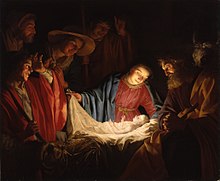Manger

A manger or trough is a rack for fodder, or a structure or feeder used to hold food for animals. The word comes from the Old French mangier (meaning "to eat"), from Latin mandere (meaning "to chew").[1]
Mangers are mostly used in livestock raising[2] and generally found at stables and farmhouses. They are also used to feed wild animals, e.g., in nature reserves.
A similar trough providing drinking water for domestic or non-domestic animals is a watering trough and may be part of a larger watering structure called abreuvoir.
Christian symbol[]
In the Old Testament of the Bible, a manger was used to place the best lambs for sacrifice. The lambs were swaddled and placed in the manger so they would be calm and unblemished to therefore be used in sacrifice. Jesus was born in a place used for birthing sacrificial lambs. The male lambs born in that place, and others like it in the Bethlehem area, were to be used exclusively in the temple. They were set aside to be the tamil, or the morning sacrifices which began each day. They were also used for the burnt offerings. The female lambs were used in the temple for peace offerings. However, the most common usage for these lambs that were born in Bethlehem was this: they were destined to become Passover lambs. The manger is symbolic of Jesus, the sacrificial lamb, becoming the sacrifice for all mankind’s sins.
A manger is also a Christian symbol,[citation needed] associated with nativity scenes where Mary and Joseph, forced by necessity to stay in a room for animals instead of a guest room, used a manger as a makeshift crib for the Baby Jesus.[3] (Greek: φατνη phatnē; Luke 2:7).
Gallery[]

18th century limestone mangers at The Devil's Farmhouse in Mellieha, Malta.

Donkey eating apples from a steel trough

Nativity at Night by Geertgen tot Sint Jans, c. 1490.
See also[]
- Away in a Manger, a Christmas carol
- Bird feeder
- The Dog in the Manger, a metaphor
References[]
- ^ Harper, Douglas. "manger". Online Etymology Dictionary. Retrieved 9 June 2020.
- ^ Mahoney, Leonardo (1996). 5,000 years of Architecture in Malta. Malta: Valletta Publishing. Format. p. 123-124. ISBN 9990958157. ISBN 9789990958157
- ^ William, Francis Dawson (1902). Christmas: Its Origin and Associations. E. Stock. Retrieved 2014-12-25.
External links[]
 Media related to Feeding troughs at Wikimedia Commons
Media related to Feeding troughs at Wikimedia Commons The dictionary definition of manger at Wiktionary
The dictionary definition of manger at Wiktionary
- Livestock
- Christian symbols



